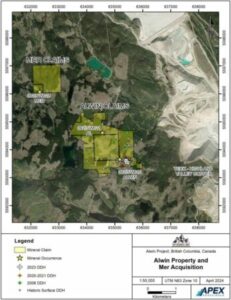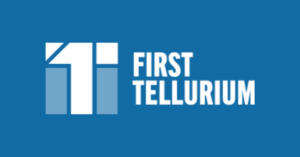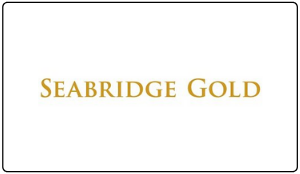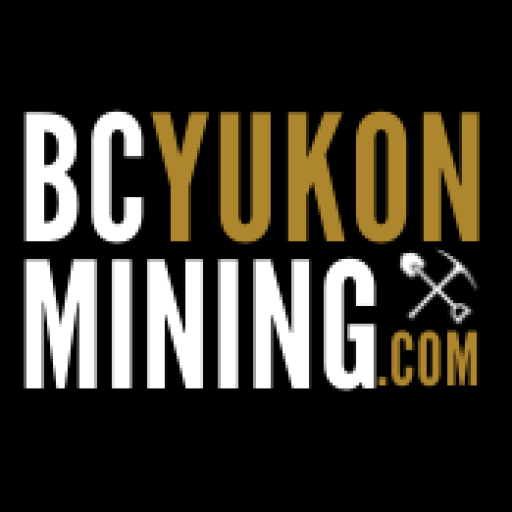| Highlights Include: 6 diamond drill holes totalling 1,364m tested the Betty Ford target along an approximately 500m strike length, with hole lengths ranging from 190 to 278m (Figure 2).2 of 6 diamond drill holes intersected significant broad zones of near surface gold mineralization across a 100m strike length, including: Hole D003 intersected 50.0m of 3.46 g/t Au from 33.0m including a higher-grade core of 5.25 g/t Au over 19.0m down hole and an upper zone of 1.14 g/t Au over 6.1m from 15.9m (Figures 3 & 3a).Hole D001 intersected 48.0m of 1.17 g/t Au from 19.0m including a higher-grade core of 2.38 g/t Au over 10.0m and an upper zone of 9.03 g/t Au over 1.0m from 6.0m (Figure 4).Gold mineralization is hosted within a newly identified east-west striking subvertical polylithic breccia unit that is 40m to 60m thick.The soil geochemical anomaly indicates that the shallow zone of gold mineralization remains open along strike to the east and 200m to the west.Drilling encountered 2 styles of mineralization: 1) broad zones (50m) of gold-silver mineralization within the polylithic breccia in holes BETFD21D001 and 003; and 2) narrower zones (1-5m) of silver-zinc-lead mineralization which was intersected in all holes.The Betty property is located on the eastern extension of the Coffee Creek Fault, which hosts Newmont’s Coffee deposit. The 2021 maiden diamond drill program focused on 2 of 5 targets identified on the Betty property, with drill testing of the other targets planned for next year’s program.A detailed review of all available exploration and drilling data is currently in progress to help guide further drill testing.A video overview from management discussing these results in more detail can be found at: https://www.youtube.com/watch?v=QlI-JyiCaJE Results from additional 2021 diamond drilling and other exploration activities will be forthcoming in due course. Figures accompanying this news release can be found at: https://whitegoldcorp.ca/investors/exploration-highlights/. Assay results are summarized below in Table 1, and drill hole collar details are provided in Table 2. “We are very excited by the results from our maiden diamond drill program on the Betty Ford target” stated David D’Onofrio, CEO. “Hole 3 ranks amongst the best holes drilled in the district, including at our flagship Golden Saddle deposit, and has considerably extended the recently discovered broad zone of near surface gold mineralization, while encountering significantly higher-grade gold mineralization and remains open along strike. We look forward to following up on these exciting results and to testing the other prospective targets on the Betty property, located in such close proximity to existing large gold and copper deposits and situated along the same fault structure”. Shawn Ryan, Co-Founder and Chief Technical Advisor stated, “It’s nice to finally see the Betty Project get its first round of diamond drilling. I staked the project back in 2010 to cover two key intersecting regional structures, namely the Dip Creek fault (NE) and the prospective Coffee Creek fault (EW). Since then, we have conducted a systematic soil program that has outlined a large gold mineralized system. This is the same exploration path that led to the discovery of the Golden Saddle and Coffee deposits. Comparing the Betty hole BETFD21D003 gold grade and intensity to the Golden Saddle and Coffee deposits, reminds me of Underworld 2008 drilling on the Golden Saddle, which is now owned by White Gold, where Hole 21 intersected 50m of 3.1 g/t Au with a follow up hole WD09-31 in 2009 returning 104m of 3.39 g/t Au. We also saw similar intensities in the Coffee’s Double-Double zone where they intersected 33.5 m of 5.1 g/t Au. This diamond drilling program is a great start to hopefully leading to the Yukon’s next big discovery.” |
| Figure 1 – Betty Ford Target Regional Map |
| Figure 1a – Betty Property Regional Aeromagnetic Map |
| Table 1. Summary of 2021 Diamond Drilling Gold Assay Results at the Betty Ford Target. |
| * Note: All drill hole intercepts reported herein are core lengths. Currently there is insufficient data to estimate true thicknesses. |
| Betty Ford Target The Betty Ford target is located in the centre of the Betty property and forms an approximately 1 km long east-west trending gold-in-soil anomaly with gold values ranging from trace up to 1,961 ppb Au. Bedrock exposure in this area is extremely limited and existing property-scale geology maps indicate the area is underlain predominately by metasedimentary rocks comprising quartzite and muscovite and/or biotite schists. The Betty property is located on the eastern extension of the Coffee Creek Fault, which hosts Newmont’s Coffee deposit In 2018 a 6-hole RAB drilling program by the Company tested the central portion of the soil anomaly and 3 holes encountered gold mineralization including 0.94 g/t Au over 24.39m in BETFRDRAB18-001, 1.08 g/t Au over 50.29m in BETFRDRAB18-002, and 0.75 g/t Au over 13.72m in BETFRDRAB18-003. The 2021 diamond drilling results reported here represents the first follow up drilling since the original 2018 discovery. 2021 Diamond Drilling Program The 2021 diamond drilling program at the Betty Ford target comprised 6 holes totalling 1,364m which tested the target area along an approximately 500m strike length with hole lengths ranging from 190 to 278m. The 4 westernmost holes (BETFD21D001 to 004) were drilled to the south (180°) at dips of -50°, and the 2 easternmost holes (BETFD21D005 & 006) were drilled to the southwest (210°) at a dip of -50°. |
| Figure 2 – Betty Ford Target 2021 Diamond Drilling |
| Results Hole BETFD21D001 was drilled to validate BETFRDRAB18-002 which had returned the best gold intercept (1.08 g/t Au over 50.29m) in 2018 RAB drilling. BETFD21D001 confirmed the overall thickness and grade of gold mineralization, returning a narrow high-grade gold intercept directly beneath overburden grading 9.03 g/t Au over 1.0 from 6.0-7.0m, and an underlying main zone that returned 1.17 g/t Au over 48.0m from 19.0-67.0m. The mineralization also contains silver values in the range of 2.50 to 3.40 g/t Ag. Mineralization is hosted within a newly identified east-west striking subvertical polylithic breccia unit that is approximately 40-60m thick which is bounded by metasedimentary rocks (quartzites, and muscovite and biotite schists) to the north and south. The breccia contains angular to sub-rounded fragments of a wide variety of lithologies (metasediments, porphyry, tuff, fuchsitic-altered mafic to ultramafic rocks, quartz vein fragments, etc.) ranging in size from millimetres to decimetres, varies from matrix to clast-supported, and contains minor (trace-2%) disseminated and cubic pyrite in the matrix. Hole BETFD21D003 was drilled 100m east and along strike from BETFD21D001, and also intersected a broad zone of gold mineralization. An upper zone returned 1.14 g/t Au over 6.1m from 15.9 to 22.0m, and the underlying main zone returned 3.46 g/t Au over 50.0m from 33.0 to 83.0m, which included a higher-grade core that averaged 4.47 g/t Au over 30.0m from 44.0-74.0m including 5.25 g/t Au over 19.0m from 44.0-63.0m. Silver values in the mineralized zones in this hole ranged between 4.25 and 5.19 g/t Ag. Hole BETFD21D002 was drilled to undercut hole BETFD21D001 by approximately 50m, and BETFD21D004 was drilled to test for a strike extension 100m to the west. Neither hole intersected significant gold mineralization, however a second style of polymetallic mineralization was encountered. These form relatively narrow zones (1-3m) of silver-zinc-lead mineralization with metal values in the range of 7.4 to 159.0 g/t Ag, 385 – 3,660 ppm Zn and 72 – 2,211 ppm Pb. Holes BETFD21D005 & 006, which drilled further to the east, did not intersect significant gold mineralization but again encountered narrow zones (0.75 – 5.30m) of silver-zinc-lead mineralization. Mineralized zones in these holes averaged in the range of 13.23 – 57.85 g/t Ag, 86 – 3,197 ppm Zn and 452 – 2,780 ppm Pb. Interpretation & Next Step |
| Figure 3 – Betty Ford Target Geological Cross Section 1 |
| Figure 3a – Betty Ford Target Core Photos |
| The preliminary interpretation suggests that the main zones of significant gold mineralization encountered in holes BETFD21D001 and 003 are hosted in an upper oxidized and transition (oxide to sulphide) zone, which is underlain by a relatively unmineralized sulphide domain within the polylithic breccia unit. The soil geochemical anomaly indicates that the gold mineralized zone remains open along strike to the east and 200m to the west, possibly confined to shallow depths (50-75m below surface) related to oxidation. |
| Figure 4 – Betty Ford Geological Cross Section 2 |
| Hole BETFD21D002 which undercut hole BETFD21D001 did not encounter any gold mineralization, despite drilling through a thick section of the host polylithic breccia, possibly drilled below the gold mineralized oxide-transition zones. It also appears possible that holes which tested the zone along strike to the west (BETFD21D004) and east (BETFD21D006) may have also intersected the polylithic breccia unit below the oxide-transition zones, explaining the absence of significant gold mineralization in these holes. The narrower zones of Ag-Zn-Pb mineralization encountered may represent distal mineralization to a possible porphyry system. Historic RC drilling at the Company’s Mascot target located approximately 6 km east-southeast of the Betty Ford target encountered intrusion-related mineralization with a similar Ag-Zn-Pb association, however gold content is notably higher at Mascot, including 2.62 g/t Au over 41.1m in hole BETR12-022 (see “About the Betty Property” below for more detail). The structural geological setting of the Betty property is complex, however the Company has made significant progress in developing a better understanding of structural controls related to several different styles of mineralization (see Company news release dated August 11, 2021). Over the coming months the Company’s geologists and consultants will be carrying out a thorough review and detailed interpretation of all existing exploration and drilling data. Follow-up diamond drilling at the Betty Ford target next season will focus on tracing the near-surface extensions of the significant gold zone that has been identified in holes BETFD21D001 and 003. Additional prospective targets on the property, in particular the large Mascot target, will also be tested by diamond drilling. In addition to the diamond drilling carried out on the Betty Ford target, drilling was also carried out on the Betty White target located approximately 750m to the north. Assay results for the latter drilling are pending and will be announced in due course. Table 2. Collar Details for 2021 Diamond Drill Holes at the Betty Ford Target. |
| About the Betty Property The Betty property comprises 860 quartz claims which cover an area of 17,127 hectares and is strategically located contiguous to and 15 km northeast of Western Copper and Gold Corporation’s Casino porphyry deposit and 40 km east of Newmont Corporation’s Coffee Gold deposit. The property hosts several early-stage exploration targets including the Betty Ford, Betty White, Betty Grable, Betty Black and Mascot targets. The property was originally staked in 2010 and since that time has seen intermittent exploration. Early work from 2010 to 2013 was carried out by Ethos Gold Corp. (“Ethos”) (TSXV: ECC; OTCQB: ETHOF; FRA: 1ET) which completed soil geochemistry surveys (coarse grid), airborne magnetic and radiometric surveys, the acquisition of high-resolution satellite imagery, trenching and reverse circulation (RC) drilling. The majority of Ethos’s work was focused in the Mascot target area leaving large portions of the property underexplored. More recent work has included mapping and prospecting, infill soil geochemistry sampling, ground geophysical surveys (Induced Polarization-Resistivity, and Magnetics – VLF-EM), LiDAR surveys, GT probe sampling and RAB drilling in 2018. Significant historical RC & RAB drilling results include 2.62 g/t Au over 41.1m in hole BETR12-022, 29.75 g/t Au over 3.1m in BETR12-012 and 2.19 g/t Au over 10.7m in BETR12-014 in Ethos RC drilling at the Mascot target, and 1.08 g/t Au over 50.29m in hole BETFRDRAB18-002 in 2018 RAB drilling by the Company at the Betty Ford target. The Betty property is underlain primarily by Late Devonian metasedimentary rocks of the Snowcap Assemblage which have been intruded by the Middle Cretaceous Dawson Range granodiorite and diorite in the southern portion of the property. The structural geological setting of the property area is complex with 4 major fault arrays being recognized: 1) WNW-trending Yukon River Shear Zone (YRSZ); 2) E-W trending Coffee Creek fault; 3) NW-trending Big Creek fault; and 4) NE-trending Dip Creek fault. The earliest faults are W to WNW trending, southerly verging thrust faults (later movement is dextral strike slip) including the Coffee Creek Fault and Yukon River Shear Zone, and NW trending oblique second order faults. Later fault systems include the NW-trending Big Creek Fault and the NE-trending Dip Creek Fault. Additional 2nd and 3rd order faults also developed at this time, possibly in the Mid to Late Cretaceous. The most important structures controlling gold mineralization as outlined by soil geochemistry appear to be 2nd and 3rd order NE trending and W trending structures. These areas include the Betty Ford, Betty White, Betty Grable and Mascot zones. More rarely gold mineralization appears to be associated with regional scale structures as is the case with the Betty Black zone on the Coffee Creek Fault. Based on soil geochemistry and structural interpretations, the property is prospective for several styles of mineralization including orogenic gold, intrusion-related gold, and porphyry copper (Au/Mo) mineralization. QA/QC Analytical work for the 2021 diamond drilling program was performed by ALS Canada Ltd., an internationally recognized analytical services provider, at its North Vancouver, British Columbia laboratory. Sample preparation was carried out at its Whitehorse, Yukon facility. All diamond drill core samples were prepared using procedure PREP-31H (crush 70% less than 2mm, riffle split off 500g, pulverize split to better than 85% passing 75 microns) and analyzed by method Au-AA23 (30g fire assay with AAS finish) and ME-ICP41 (0.5g, aqua regia digestion and ICP-AES analysis). Samples containing >10 g/t Au were reanalyzed using method Au-GRAV21 (30g Fire Assay with gravimetric finish). The reported work was completed using industry standard procedures, including a quality assurance/quality control (“QA/QC”) program consisting of the insertion of certified standards, blanks and duplicates into the sample stream. |










